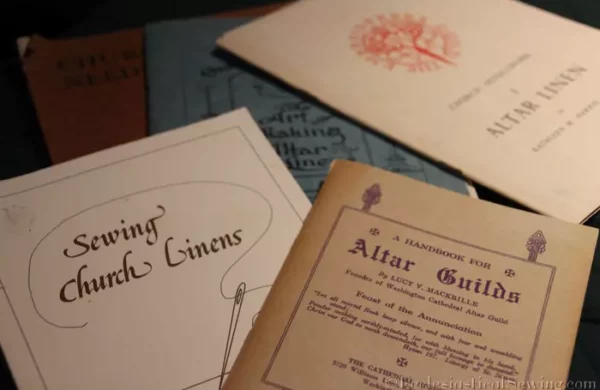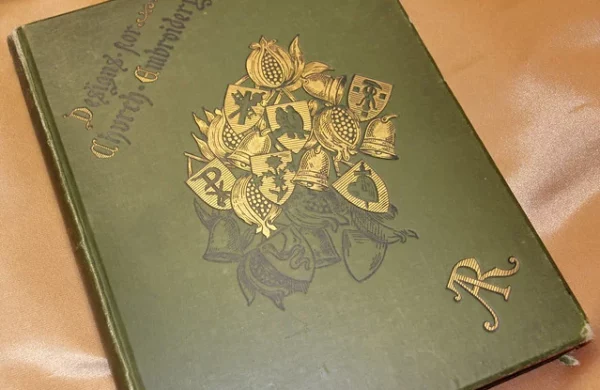
The Chasuble Percy Dearmer
The Chasuble Percy Dearmer The Chasuble Percy Dearmer: Did you ever look at a poncho and think that it reminded you of something familiar? We know that the poncho,… Read more The Chasuble Percy Dearmer →
Creating Your Own Church Vestments: A Fulfilling and Rewarding Experience
Sewing a vestment can be a fulfilling and rewarding experience, especially if you’re creating it for your own church or parish. But where do you start? Here are some tips to help you get started.
Choose a Pattern that Suits Your Skill Level
When it comes to sewing church vestments, it’s essential to choose a pattern that suits your skill level. Ecclesiastical Sewing offers a wide range of patterns for various types of vestments such as chasubles, stoles, and copes. With Ecclesiastical Sewing, you can find the appropriate pattern that will help you create beautiful and meaningful vestments for your church.
Enhance Your Skills with Vintage Books
In addition to patterns, there are many vintage books available that could help you enhance your sewing and embroidery skills, specifically for creating different types of vestments. Ecclesiastical Sewing is a great resource for reprinted books about vestment sewing and embroidery designs that provide detailed instructions and techniques to help you create beautiful and intricate vestments.
Choose High-Quality Fabrics
When it comes to materials, it’s important to choose quality fabrics, such as brocade, silk, linen, or wool. These fabrics are durable and will ensure that your vestment lasts for years.
You can also add decorative elements to your vestment, such as embroidery, lace, or appliques, to give it a unique and personal touch.
Thus, creating your own church vestment can be a rewarding experience that allows you to showcase your creativity and skills. With the right sewing patterns and books, you can create a vestment that is not only beautiful but also meaningful. So why not give it a try and see what you can create?

The Chasuble Percy Dearmer The Chasuble Percy Dearmer: Did you ever look at a poncho and think that it reminded you of something familiar? We know that the poncho,… Read more The Chasuble Percy Dearmer →

he Alb is a vestment that can trace its origin to six ancient garments: the Kolobus, the Tunica, the Colobim, the Tunica Talaris, the Subucula, and finally the Tunica Alba. These garments were common in Greek or Roman times, some garments being used by both cultures. They are not six manifestations of one garment, but rather six that are distinct enough to make note of the differences.

The measurement of making an Altar Fair Linen – The altar height: measure from the top edge of the altar to the floor. Measure the width of the altar from the front to the back. Measure the length of the altar from one side to the opposite side. Optional: measure the hang from the top edge down the side of the Fair Linen to match the length of an altar hanging.

Altar linens serve distinct liturgical functions: Fair Linen covers the altar, Corporal holds vessels, Pall a square linen stiffened with either cardboard or plexiglass. Purificator a small square linen used to wipe the communion vessels during the sacrament, Lavabo Towel dries hands, Credence Cloth covers a side table, Chalice Veil conceals post-communion, Cere Cloth protects from dampness, Dust Cloth safeguards Fair Linen, and Sick Call Set facilitates individual communion.

In the late 1800s, Mary Barber created a lovely collection of many examples of Opus Anglicanum.

The design is a simple cross with three rays in each corner between cross bars. The Altar Linen Embroidery Design is available in 4 sizes, for purificators, lavabos, corporal a, and even the corners of a fair linen. This church linen embroidery design will use a few basic stitches such as the split stitch for an outline, and a stem stitch for the rays

Wishlist of the Royal School of Needlework for years, plans were cancelled by scheduling conflicts. Yet, browsing to their online store provided a silver lining. The Handbook of Embroidery catalog and some enticing embroidery While missing out the classes, the excitement of exploring these ecclesiastical embroidery treasures brings comfort.
Monk Habit Pattern – Benedictine style. It is a simple monk habit that has a high, close-fitting collar, a front placket opening, long 2-piece sleeves, welt pockets on the chest, and at the waist, and side openings to access pant pockets.
The Clergy presiding over the service wore matching cream-colored vestments with tapestry orphreys. Another clergy wore vestments such as surplices, dalmatic, tunic, and chasuble, according to their role and position within the church. Clergy robed in matching white chasubles lined the stairs to pay their last respects as the flag-draped coffin left the Cathedral

Author notes from original copy
– The color card at the beginning of the book has been inserted by the kind permission of Messrs. Liberty & Co., of Regent Street, London; and A. R. cannot say enough in praise of their colors and the Filo Floss silks sold by them. Many of the colors, she says, are perfect; and this verdict is made after comparing them with many original pictures of the old masters in Italy and elsewhere – the shades of red, green, blue, and browns being spoken of with special praise.

Vintage Vestment Book Treasure: The book title is written diagonally across the upper left corner, and the initials AR are in the lower left corner. The inscription or dedication also lends a bit of mystery: To my friend Alethea Wiel The Designs in this Volume are Dedicated A. R.

The Royal School of Needlework has an exhibit titled: ‘For Worship & Glory’ taking place at Chester Cathedral, 3 – 28 February 2016. The highlight of the exhibit is six pieces of the famous Litany of Lorento embroideries, which were donated to the Royal School by the nuns from the now-closed Convent of the Holy Child in Mayfield East Sussex.

Reading about techniques from church embroidery and church vestment books.
Ecclesiastical Sewing and Church vestment-making news from around the internet.

Within the Lutheran Church-Missouri Synod, red is the traditional liturgical color to be worn for installation service. And look at all of the lovely red stoles! Within our church body, it is tradition for pastors within the local circuit to attend the installation service of a brother pastor. At this installation service, there were a total of seventeen pastors vested in red stoles! There is a wealth and abundance in the variety of pastoral stoles.
You must be logged in to post a comment.